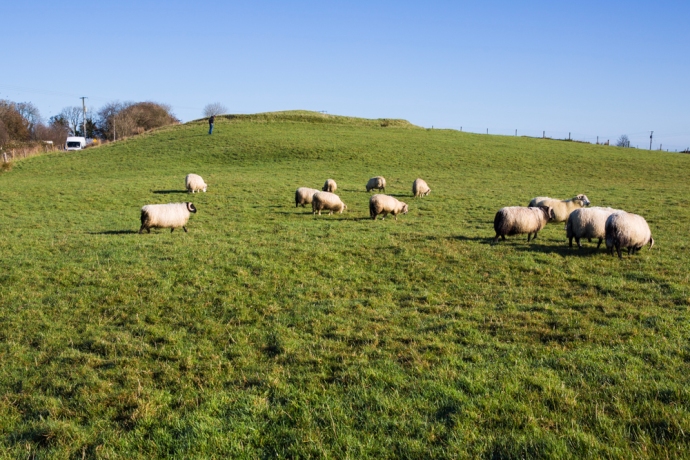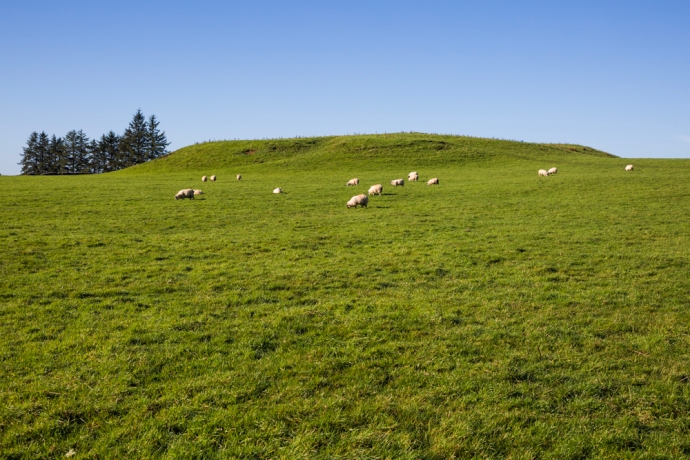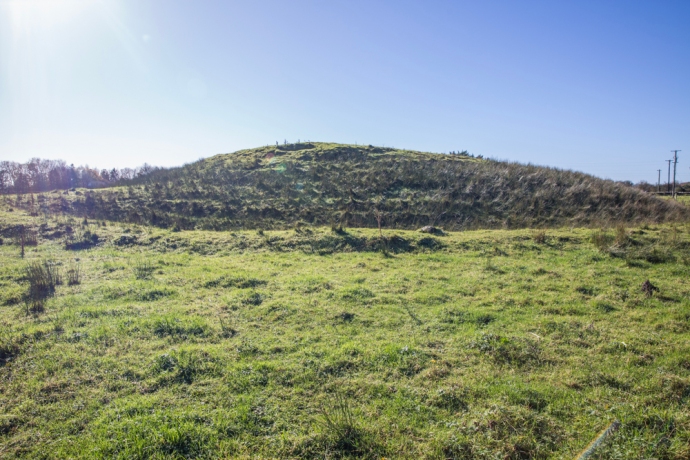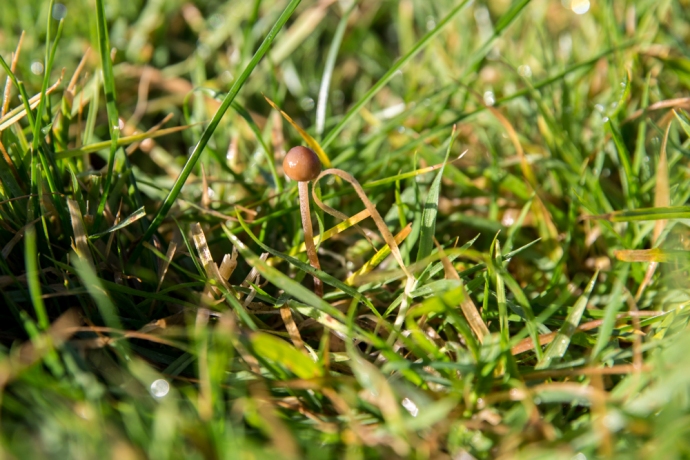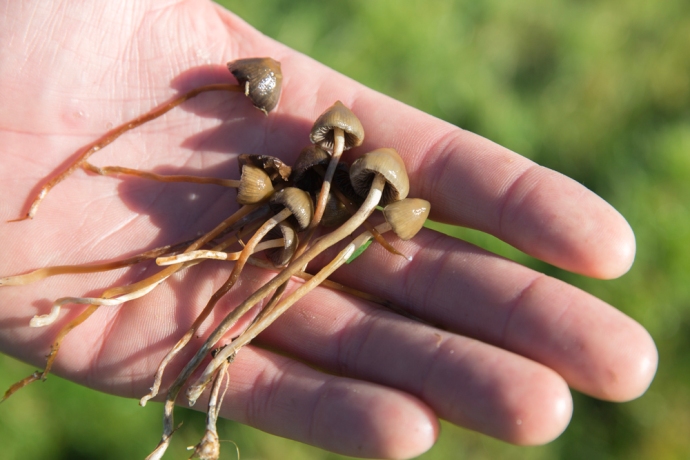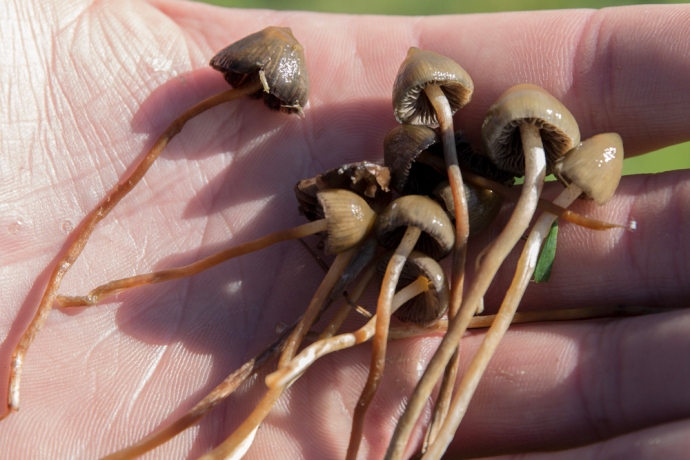Invitations like this don’t come around very often. Certainly not for me and certainly not in Ireland. Friends, Jeanne and Natasha from Albuquerque in New Mexico (in fact you can read about how we met here) were visiting again, this time for the The Irish National Hot Air Balloon Championships in County Offaly. Held annually since 1971, this is the longest running national ballooning event in the world and the biggest in Ireland. Invitation only, up to 40 balloons from around the world, fly each year in what promised to be an incredible spectacle. It was held over the week of September 24 to 28th.

Jeanne Page and Natasha Coffing. My hosts.
There was a chance I could crew. Who wouldn’t want to be part of that? But I ummed and ahed. I was still recovering from three weeks in the US. On Tuesday it was still just a thought. By Wednesday I had the kind offer of a bed from a musician friend at her magnificent BnB in Kinnitty, Ardmore Country House. House. That sealed it for me. A night or two in quite possibly one of the best BnB’s in Ireland and some fiddle tunes was the extra incentive I needed.

Ardmore Country House BnB in Kinnitty. My home for the duration.
It was only a couple of hours drive and in dull weather I arrived at the launching place, which was the dramatic gardens surrounding Birr Caste and Demesne. Preparations were well underway for the late afternoon flight. I couldn’t find my friends from Albuquerque so I watched with great interest the activities feverishly underway, as crews readied their balloons.
Balloons were being unfurled, baskets were being loaded, flames were being thrown and one by one the giant multicoloured bubbles stood upright and drifted slowly into the hazy evening. I started to put some pieces of the jigsaw together but I really had little idea of what I was watching. As the last balloon drifted over the castle I came to the realization that my friends were in the air and that they probably had to land somewhere. So I asked someone, who seemed to know, who said they were heading to Kinnitty, about 10 km to the east. Well, turned out she didn’t actually have much more of an idea than me, or perhaps the wind didn’t cooperate but, in my haste to get to Kinnitty, I failed to notice they were actually heading northeast rather than east.
I caught up later that evening with Jeanne and Natasha at Dempsey’s Bar in the charming village of Cadamstown, 10 minutes north of Kinnitty where a regular trad session was being held. The word had got out and the pub was crammed with musicians and with ballooning people. They were lucky. It was terrific music led by local box and banjo legends, the Kinsella brothers, and at least twenty other musicians with a high energy mix of tunes and songs. Jeanne and Natasha had bought their harps with them from the States and treated us to some lovely duets.

Traditional music session in Cadamstown. Natasha and Jeanne join in on their harps.
In among the tunes we discussed the possibility of a flight the next morning. My education in ballooning continued. A decision on whether flying was possible would be made at the Pilots’ Briefing at 6:30 am. Weather conditions, in particular wind speed and direction, were the primary factors. Then the teams will move to the launch site and each pilot will make the decision as to whether they will fly. I couldn’t be guaranteed a spot in the basket but if that didn’t happen I could join the chase crew. They are charged with following the balloon to be there wherever it lands, get permission from the local farmer and collect and transport the crew and the balloon back to Birr. It looked promising.
So next morning I was there. The wind was good and the weather was fine and the decision was a Go. There was a problem though. Patchy thick fog had descended and there were worries about visibility. So the crews made their way to the site for individual pilots to make their own call. It had been a cold night and frost was still covering the ground, the wetness soaking through my waterproof boots to my toes.
A few set up and started inflating their balloons but most pilots waited. The mist had created an eerie atmosphere and while the delay was disappointing it was a hugely appealing light and plenty of opportunities for the photographer in me to experiment.

Birr Castle rises from the mist

Waiting in the frost and mist for the sun to rise

Autumn reflections

The sun bursts through the fog
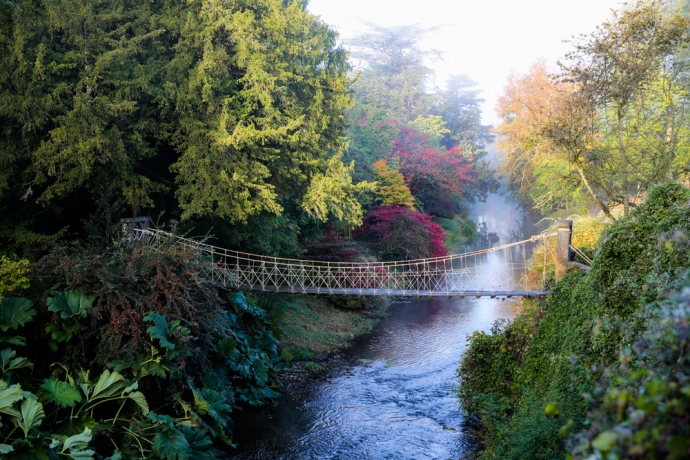
A magical misty morning. More like a Monet painting.

Island in the mist
As the sun rose the feeling was that the fog would burn away and a few started to take to the air. Our pilot Steve Coffing (who just happened to be Natasha’s uncle), though remained cautious. It seemed obvious but the primary requirement was that you need to see the ground. There was still doubt about whether the fog had lifted sufficiently to give this required visibility. We waited.
Most balloons were now in the sky, but then the fog came back in and a number of the last to lift off returned to the ground. Finally Steve decided when it became clear that we had run out of time and called off the morning flight. I was actually not particularly upset as I felt happy that despite my frozen fingers, I had captured some great images. I’ll leave it to you to judge.



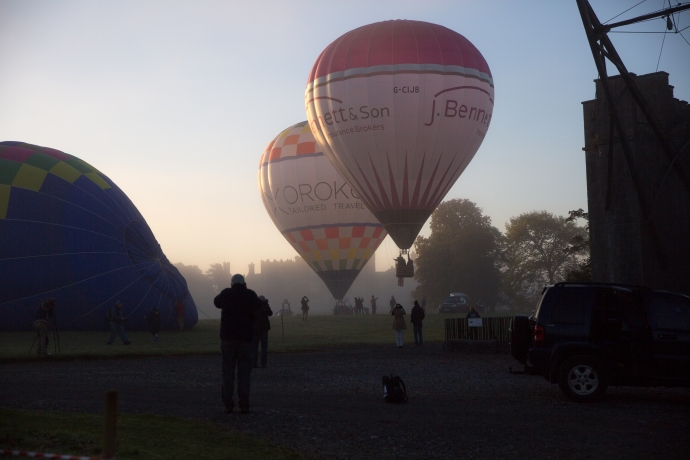


We adjourned for breakfast at a local cafe. Steve was confident the weather would be good in the evening and renewed my invitation to fly. He suggested I be at the afternoon briefing at 4.30 pm.
Once the fog lifted it turned into a cracker of a day. Perfect to explore the nearby Sieve Bloom. These low mountains straddle Offaly and Laois and are a wonderful mix of thick forests of spruce and pine, ancient oak and beech forests, open bog land, lakes and mountain streams cascading through mossy glens. It is a hiker’s’ paradise, so that’s what I did. But my mind was elsewhere.
On tenterhooks I attended the 4.30 pm briefing. It was a Go decision for the evening flight. But things had changed a little and the balloon that I had planned to fly in was needed for a check flight to maintain the owner’s licence. Steve managed to get a piloting spot on another balloon but I was told that balloon was full. Then fate stepped in. Nikki and Dylan, an Aussie couple I had met the previous night at the session in Cadamstown, came to my rescue. Friends of the owner of the balloon Steve was flying. they had already flown a couple of times earlier in the week. To my eternal gratitude they gave up their spot and it was Up Up and Away [Oh dear, I never thought I could be so cheesy as to use that line!]
I now joined the readying of the balloon for flight. Like me, most of my readers will not have flown in a balloon before. Well I became an instant expert. The physics is simple really. The nylon or dacron ‘envelope’ is filled with air using a large fan and this is heated until the balloon is upright. A basket is suspended underneath which carries up to four passengers, the pilot and a heat source. The heat source is an open flame fueled by propane, carried in tanks on the basket. The heated air reduces the density of the air inside the envelope compared with the colder air outside causing it to rise. The skill of the pilot comes in knowing how much heat to apply to make it rise or fall. Rapid descent can be achieved by opening the vent at the top with a rope causing the hot air to escape quickly. There is limited ability to change direction and reading the wind, which can change dramatically at different heights, is part of the skill of flying.
Simple really. A great achievement though for the Montgolfier brothers who built the first manned balloon in 1783. Love the way when they were testing it for manned flight, they proposed that convicted prisoners should be used for the first pilots. Dispensable.
So I watched the preparations with keen interest. The equipment is actually quite compact and is carried in a customized trailer.

Basket being removed from trailer
First the basket is prepared. The burner is then mounted over the four corners of the basket and the legs wrapped with a protective insulation.

Burner being mounted over basket

legs wrapped in insulating material

Burner is tested.
The propane is connected to the burner and the burner tested. The balloon is then unwrapped and laid out next to the basket which is now on its side. Inflation begins with a large fan. As the balloon expands the burner is turned on sporadically to heat the air. This process takes only a few minutes and when the balloon is full and the pilot is ready the heating is increased which pulls the basket to vertical.

Balloon is unwrapped and laid out. Everyone pitches in.

Balloon is filled with air

Vent flap is secured

Fan used to fill balloon

Air is heated once filled

Heating continues until balloon stands vertically
IT is now ready for take off. Passengers board. Joining Steve and myself was John Kelly, a local publican, with a deep knowledge of the surrounding landscape. We had a briefing. There were only a few simple rules. Keep an eye out for other balloons and livestock and power lines and communicate this with the pilot. And oh, Don’t get out of the basket. My total agreement with that one. I was definitely ‘crew’ now. We were ready to go.
There was a roar from the burner shooting flames into the balloon above and we rose effortlessly. There was no real sensation of take off. The ground just seemed to move away from us. In between the bursts of noise of the burner it was deathly quiet. Just this wonderful relaxing calm.

Lift off
Most balloons were ahead of us but as we rose, I could see them spread out before us. Some stayed low. Others were thousands of feet above us. Birr Castle and its magnificent grounds disappeared from view. Steve took us up to 2,000 ft just to show us what it felt like. Sometimes balloons go to 5,000 ft particularly if they have passengers who are sky diving. Oh my god. The thought of throwing yourself off this little basket from this height totally freaked me out. Fair play to those who can happily do this and actually much prefer it to jumping from a light plane as they have no forward velocity.

Leaving Birr Castle I

Leaving Birr Castle II

Leaving Birr Castle III

Who knows where we will end up?

Balloons fill the sky

At all levels

The balloon ‘Twister’ flying low. This was the balloon I was originally to fly in.



Bliss.

Our pilot Steve holding all the ropes

Soaring above the swans

Magic evening light

The evening sun casts our balloon shadow on the glowing trees

Looking for a landing spot
We drifted effortlessly with only occasional use of the burner for minor adjustments to our flight while I just breathed in the late evening light and dealt with the challenge of capturing the feeling as best I could with the camera. It wasn’t a point and shoot exercise. I found I needed to make constant adjustments to the exposure to compensate for how much sky there was or where the sun was. I was learning quickly. We were up there for nearly an hour. One wonderful hour. I know I would do a better job next time.
We made preparations to land. Steve was in constant radio contact with the ground support team. He had to consider a lot in deciding where to land. An open field with no trees, no power lines, no livestock, not under cultivation, not a bog and easy access. Lots to consider. Once he has decided the ground crew tries to determine the owner and seeks permission Normally the pilot would wait for clearance. In this case the landowner was thrilled we were landing in her paddock.
You have to admire the skill of the descent. It was controlled and steady with Steve adjusting both the horizontal ground speed and the descent speed. He jokingly told stories of a tradition in some places of leaf grabbing as pilots scrape the tops of trees.
But not this time. We touched the ground bounced a couple of times, dragged a little and then stopped . Remaining vertical all the time. A quick exit and the retrieval crew including Nikki and Dylan, who were waiting a short distance away stepped in to manage the deflation and unhooking of the basket.

Safe landing

Dylan and the chase crew was there to meet us

Pilot Steve Coffing and my fellow passenger John Kelly pose for the family album.

Nikki at the end of her tether
There was a celebratory atmosphere with the crew participating equally in the thrill that us virgin flyers so obviously had had. Of course once the balloon was packed and loaded there was just one thing to do. A few quiet ales and some songs (I had my guitar in the car) back in John Kelly’s pub in Birr. Perfect end to the day.
I had an amazing three days. So many people to thank for making this all possible. Jeanne Page and Natasha Coffing for thinking of me, Christina Byrne for sharing her house and her music, Steve Coffing for piloting with skill and aplomb and for making us feel comfortable and relaxed, Nikki and Dylan for giving up their spot in the basket and for making me a little homesick for a Home Among the Gum Trees, the owners Graeme and Judy Scaife for sharing their balloon with so many people in and outside of the ballooning community, to my fellow passenger John Kelly for helping me understand the landscape we were flying over and to Shane Page for sharing some tips for photographing balloons. The organizers need to be complimented also for there effortless coordination of a lovely relaxed few days of ‘competition’.
I think I might do that again.
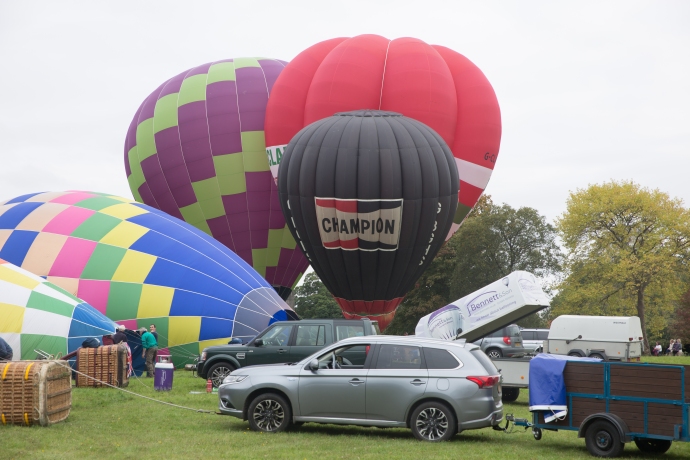
Balloons come in all shapes and colours

